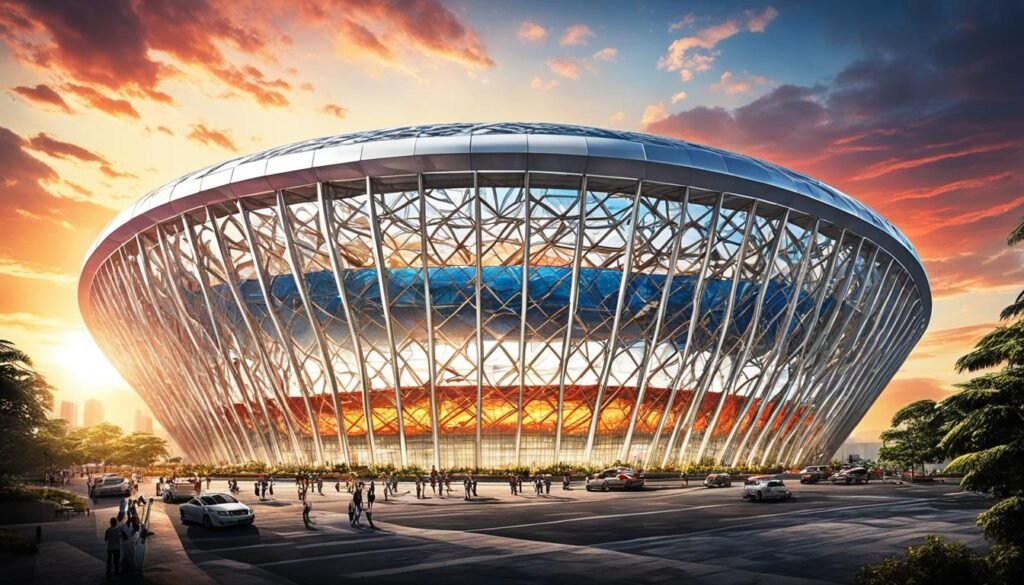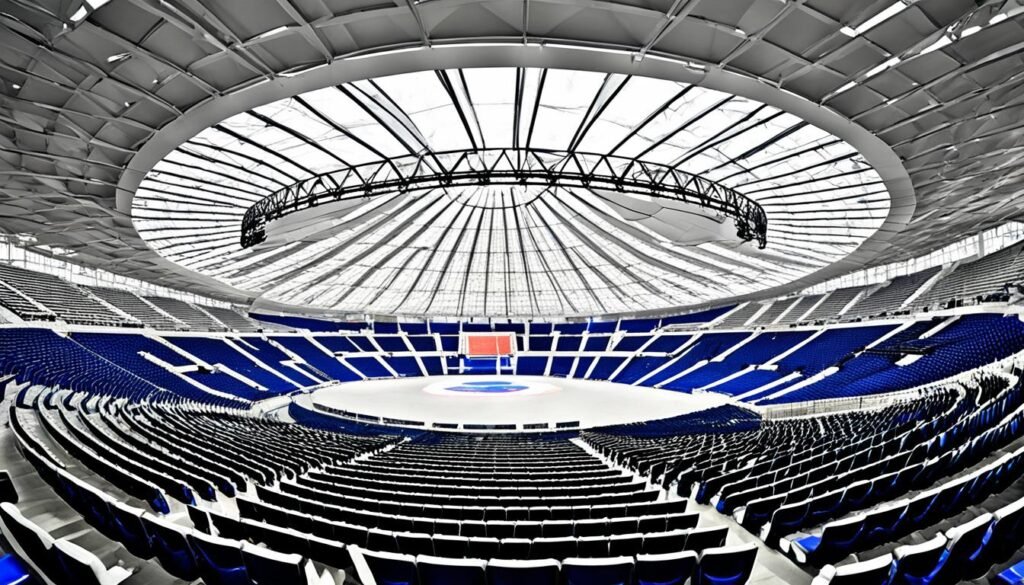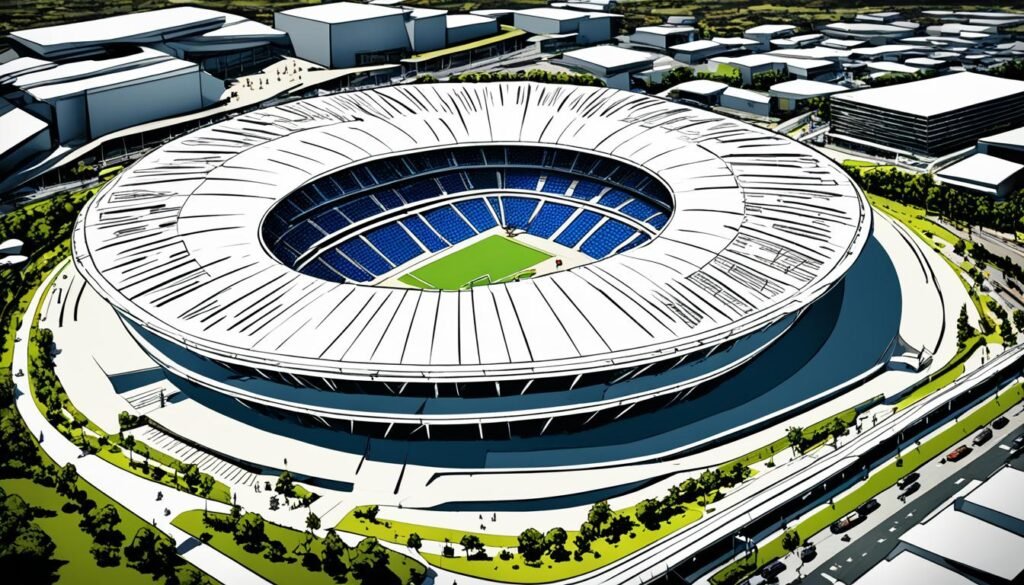The Philippine Arena is not just any ordinary venue. It is a colossal structure that stands as a symbol of national pride in the heart of the Philippines. With its impressive seat capacity, it has become a go-to destination for various events and gatherings. Let’s take a closer look at the Philippine Arena and its incredible features.
Key Takeaways:
- The Philippine Arena is the largest indoor arena in the world.
- It has a seating capacity of 55,000 people.
- The arena is known for hosting sports competitions, concerts, and religious gatherings.
- It showcases modern architectural design and innovative features.
- The Philippine Arena is a versatile venue that can accommodate a wide range of events.
Unveiling the Philippine Arena: A Modern Architectural Marvel
The Philippine Arena is not only known for its impressive size but also for its modern architectural design. The arena was designed by the architectural firm Populous and is considered to be a marvel in terms of its structural beauty. It features a dome-shaped roof and unique seating arrangements that provide excellent views from every seat in the arena. The use of cutting-edge materials and innovative design elements has made the Philippine Arena a symbol of architectural excellence.
A Monumental Endeavor: The History and Construction
The construction of the Philippine Arena was a monumental endeavor that required careful planning and execution. The groundbreaking ceremony took place on August 17, 2011, and the arena was completed on May 30, 2014. The arena was built as part of the centennial projects of the Iglesia ni Cristo (INC) and was inaugurated on July 21, 2014. The construction process involved the use of advanced engineering techniques and the collaboration of various construction firms.
From the initial concept to the final execution, the construction of the Philippine Arena showcased the sheer determination and vision of the project’s stakeholders. The planning phase involved meticulous research and analysis to ensure the arena could meet the demands of being the largest indoor arena in the world. Design considerations were made to incorporate modern architectural trends while maintaining the cultural significance of the venue.
The construction phase required the coordination of multiple construction firms, each specializing in specific aspects of the project. This collaboration ensured that every detail was meticulously executed, from the foundation to the finishing touches. The use of advanced engineering techniques and cutting-edge materials played a crucial role in creating a structurally sound and visually stunning arena.

The construction of the Philippine Arena stands as a testament to the dedication and expertise of the architects, engineers, and construction workers involved in this monumental project. Through their hard work and innovative thinking, a world-class venue was born.
Engineering Grandeur: The Architectural Design of Philippine Arena
The architectural design of the Philippine Arena is a testament to engineering grandeur. Inspired by the native flora of the Philippines, particularly the narra and banyan trees, the design showcases a harmonious blend of strength and growth.
Inspired by Native Flora: The Narra and Banyan Roots
The narra and banyan trees hold deep cultural significance in the Philippines, symbolizing resilience, endurance, and unity. These qualities are reflected in the design elements of the Philippine Arena. The structure pays homage to the soaring branches and sturdy trunks of these majestic trees, capturing their essence in its grandeur and stability.
“The design of the Philippine Arena incorporates elements of nature, providing a sense of connection to the environment while creating a monumental architectural statement.” – Architectural Team
Design Firm Populous: Creating a Modernist Icon
The architectural firm Populous played a pivotal role in shaping the vision of the Philippine Arena. Known for their expertise in designing iconic sports and entertainment venues, Populous ensured that the arena would not only be functional but also a modernist icon. The result is a structure that captivates with its sleek lines, innovative features, and timeless appeal.
Breaking New Grounds with the Arena’s Design
The design of the Philippine Arena broke new grounds in terms of its scale and architectural innovation. The imposing dome-shaped roof, made possible by advanced engineering techniques, serves as a distinctive hallmark of the arena. The seating arrangements provide unobstructed views from every angle, allowing spectators to immerse themselves in the grandeur of the events hosted within its walls.
The architectural design of the Philippine Arena is a true marvel, combining engineering prowess with artistic vision. Its inspired by native flora, collaboration with design firm Populous, and groundbreaking features have elevated the arena to a symbol of architectural excellence in the Philippines.
The Philippine Arena Up Close: Technical Specifications Revealed
Taking a closer look at the Philippine Arena, we discover its impressive technical specifications. The arena has a total floor area of 36,443.6 square meters and stands at a height of 65 meters. The roof of the arena covers an area of 35,948 square meters and is made of lightweight materials to minimize the load on the structure. The arena features multiple levels, including a stage level, a main access level, a VIP area, and an upper concourse. These specifications contribute to the arena’s ability to accommodate large-scale events and provide a memorable experience for spectators.

| Technical Specifications | Measurements |
|---|---|
| Total Floor Area | 36,443.6 square meters |
| Arena Height | 65 meters |
| Roof Area | 35,948 square meters |
| Levels |
|
Philippine Arena, Seat Capacity: A Breakdown of Its Immensity
The seating capacity of the Philippine Arena is a remarkable feature of this colossal venue. The arena is divided into the lower and upper bowl, each with a seating capacity of approximately 25,000. This segmentation allows for maximum capacity and convenient crowd management.
The Lower and Upper Bowl: Segmented for Maximum Capacity
The lower and upper bowl of the Philippine Arena are specifically designed to accommodate a large number of spectators. The lower bowl encompasses the closer sections to the stage, while the upper bowl offers elevated seating areas. This segmentation allows for efficient distribution of attendees and ensures that everyone has a clear view of the event.
The Seating Configuration: Inspired by Greek Theaters
The seating configuration of the Philippine Arena draws inspiration from Greek theaters. The seats are arranged in a semi-circle around the stage, creating an immersive experience for the audience. This configuration ensures that every seat provides an excellent view of the performance or event, allowing attendees to fully enjoy the immersive experience.
Retractable Seating Innovations and VIP Accommodations
To enhance the versatility of the Philippine Arena, retractable seating innovations have been implemented. This allows for the flexibility to configure the seating arrangement according to the specific needs of different events. Additionally, the arena offers VIP accommodations for a premium experience for those seeking utmost comfort and luxury.
With its exceptional seat capacity and thoughtful seating design, the Philippine Arena ensures an unforgettable experience for every attendee, whether they are cheering for their favorite sports team, enjoying a concert, or attending a religious gathering. The immensity of the Philippine Arena’s seating capacity contributes to its status as one of the world’s most impressive indoor venues.
Safety Grounded in Innovation: Structural and Earthquake-Resilient Features
Safety is a top priority at the Philippine Arena, and innovative structural features have been incorporated to ensure the protection of spectators and the building itself. The use of cutting-edge materials enhances the durability and longevity of the structure. Shock absorbers and seismic joints have been installed to prepare for the impact of earthquakes and prevent damage. Additionally, the arena’s roof is designed without joints to withstand the tropical climate and prevent water leaks.

Redefining Durability: The Use of Cutting-Edge Materials
The Philippine Arena exemplifies durability through the use of cutting-edge materials in its construction. The structure is built to withstand the test of time, ensuring the safety and comfort of all those within its walls. These materials not only enhance the strength and resilience of the arena but also contribute to its aesthetic appeal.
Shock Absorbers and Seismic Joints: Preparing for the Unseen
Earthquakes are a common occurrence in the Philippines, and the Philippine Arena is designed to withstand these seismic events. Shock absorbers and seismic joints have been strategically placed throughout the building to absorb and dissipate the energy generated during an earthquake, minimizing potential damage and ensuring the safety of everyone inside. These innovative features provide peace of mind to both event organizers and attendees.
Designing for the Tropics: A Roof Without Joints
The tropical climate of the Philippines poses unique challenges in building design, particularly when it comes to preventing water leaks. The Philippine Arena’s roof is seamlessly designed without joints, significantly reducing the risk of water infiltration. This innovative approach ensures a dry and comfortable environment for spectators, even during heavy rain.
A Versatile Venue: Hosting a Myriad of Events at the Philippine Arena
The Philippine Arena is more than just a colossal venue with an impressive seating capacity, it is also a versatile space that can accommodate a wide range of events. From sports competitions to concerts and music festivals, the Philippine Arena has played host to a myriad of significant gatherings.
When it comes to sports, the Philippine Arena has been the stage for thrilling basketball games, intense boxing matches, and even the prestigious FIBA Basketball World Cup. The state-of-the-art facilities and the grandeur of the arena provide an unparalleled experience for both athletes and spectators.
Not just limited to sports, the Philippine Arena has also become a favored venue for concerts and music festivals. Many international and local artists have graced its stage, captivating audiences with their performances. The acoustics and the vast seating arrangement of the arena create an immersive atmosphere, ensuring an unforgettable experience for concert-goers.
Organizers seeking to host events that leave a lasting impact often choose the Philippine Arena. Its versatility, combined with its modern facilities and world-class amenities, make it the perfect venue for conferences, exhibitions, and other large-scale gatherings. The sheer size and adaptable nature of the Philippine Arena offer endless possibilities for event customization and audience engagement.
Philippine Arena’s Legacy: Landmark Events and Attendance Milestones
Over the years, the Philippine Arena has played host to numerous landmark events and achieved significant attendance milestones. This iconic venue has been the stage for major basketball games, including the prestigious PBA Philippine Cup and the thrilling FIBA 3×3 World Cup. With its state-of-the-art facilities and grandeur, the Philippine Arena has also become a popular choice for religious gatherings and celebrations, attracting thousands of attendees.
These landmark events have left an indelible mark on the legacy of the Philippine Arena. They have solidified its reputation as a premier event venue in the Philippines, showcasing its ability to accommodate diverse events and create unforgettable experiences for spectators. The Philippine Arena’s commitment to excellence has made it a go-to destination for organizers and attendees alike.

“The Philippine Arena has witnessed some of the most incredible moments in Philippine sports history and has been a gathering place for people from all walks of life. Its legacy is built on the unforgettable events and shared experiences that have taken place within its walls.”
Conclusion
The Philippine Arena stands as a testament to architectural excellence, engineering innovation, and versatility. This colossal venue with its remarkable history, design, technical specifications, and safety features has become a symbol of national pride in the Philippines. With a seating capacity of 55,000, it is the largest indoor arena in the world and a true marvel of modern architecture.
Designed by the renowned architectural firm Populous, the Philippine Arena showcases a unique combination of form and function. Inspired by the native flora of the Philippines, the design elements pay homage to the strength and growth represented by the narra and banyan trees. This architectural masterpiece has broken new grounds with its scale and innovation, creating a lasting impact on the landscape of the country.
As a versatile venue, the Philippine Arena has hosted a myriad of events, from sports competitions to concerts and religious gatherings. Its state-of-the-art facilities and innovative seating configurations provide every spectator with an exceptional experience, ensuring excellent views from every seat. With its prominent role in hosting landmark events and achieving attendance milestones, the Philippine Arena has cemented its place as an iconic landmark in the heart of the Philippines.
In conclusion, the Philippine Arena stands tall as a symbol of architectural brilliance and engineering grandeur. It is an architectural marvel that embodies the spirit of the Philippines. With its rich history, monumental construction, impressive technical specifications, and unwavering commitment to safety, the Philippine Arena is an undeniable source of pride for the nation and a beacon of excellence in the world of entertainment and sports.
FAQ
What is the seating capacity of the Philippine Arena?
The Philippine Arena has a seating capacity of 55,000 people, making it the largest indoor arena in the world.
Who owns and operates the Philippine Arena?
The arena is owned by New Era University and operated by the Maligaya Development Corporation.
What kinds of events are held at the Philippine Arena?
The Philippine Arena hosts a variety of events, including sports competitions, concerts, and religious gatherings.
When was the Philippine Arena constructed?
The construction of the Philippine Arena began on August 17, 2011, and was completed on May 30, 2014.
Who designed the Philippine Arena?
The architectural firm Populous designed the Philippine Arena, creating a modernist icon.
What are the technical specifications of the Philippine Arena?
The Philippine Arena has a total floor area of 36,443.6 square meters and stands at a height of 65 meters.
How is the seating arranged in the Philippine Arena?
The seating in the Philippine Arena is configured in a semi-circle around the stage, inspired by Greek theaters.
What safety features does the Philippine Arena have?
The Philippine Arena incorporates cutting-edge materials, shock absorbers, seismic joints, and a roof without joints to ensure safety and durability.
Can the Philippine Arena accommodate large-scale events?
Yes, the Philippine Arena’s large seating capacity and versatile design allow it to host a wide range of events, from sports competitions to concerts.
What landmark events have been held at the Philippine Arena?
The Philippine Arena has hosted major basketball games, religious gatherings, and celebrations, attracting thousands of attendees.
Source Links
- https://en.wikipedia.org/wiki/Philippine_Arena
- https://en.wikipedia.org/wiki/Philippine_Sports_Stadium
- https://www.hwenc.com/majorprojects/philippine-arena.do

